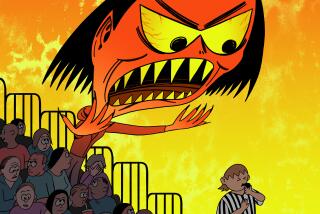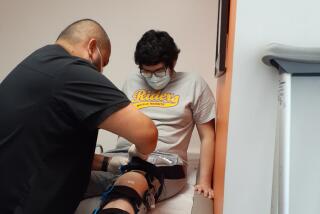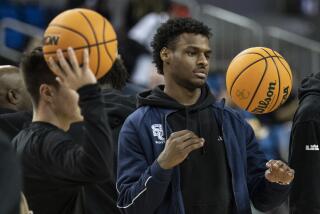Pushed to the Max
While doctors and fitness experts urge America’s car-coddled couch potatoes to get outdoors, kick a soccer ball or swing a tennis racquet, they’re also concerned about kids at the other extreme--the athletes suffering overuse injuries, stress and even depression when they should be having the time of their lives.
The rash of injuries has hit two groups of kids--those who’ve rarely seen the inside of a gym and suddenly make a team, and in-shape youngsters who play one or more sports, perhaps competing at elite levels.
“We’re talking about a new disease in children, and we’re just scratching the surface as to how we can prevent it,” says Dr. Lyle Micheli, director of sports medicine at Boston Children’s Hospital.
An estimated 20 million to 30 million U.S. children participate in organized sports, coached largely by volunteers without formal training. That’s more participants than in the past because there are more organized sports and kids are getting started earlier.
Many of these young athletes are otherwise sedentary kids who join teams where coaches and parents will push them to practice harder, travel further and compete more seriously. Sports camps and specialized programs identify potential standouts as early as junior high. Witness the soccer moms and dads who chauffeur their kids to matches year-round, or the parents who hover intently at hockey games or gymnastics meets.
With a celebrity culture that glamorizes professional sports, the stakes have risen for kids seeking elusive athletic scholarships and recognition.
Also on the rise is the potential for problems.
Swimming offers a case study.
“Here at Indiana University, [Olympic gold medalist] Mark Spitz trained 10,000 yards a day--maybe 6 miles--back in 1972,” says Jack Raglin, an exercise scientist at the school. “[Now] there are 12-year-olds who do more than that . . . train more than the greatest swimmer who ever lived.”
Is such intensive training necessary?
Before high school, “there are very few sports where it’s important to have a lot of playing time to excel as an adult or as a college student,” says Dr. Greg Landry, a pediatrician and sports medicine specialist at the University of Wisconsin Medical School.
Adults Often Lose Sight of the True Objective
Too often, parents and coaches lose sight of what youth sports is supposed to be all about.
“Adults need to be reminded . . . why children play,” Landry says. “At young ages, winning is not as important as participating and having fun.”
Too much, too soon can lead to overuse injuries, the damage and inflammation caused by repeating the same movements over time.
Tendinitis. Bursitis. Little League elbow. Shinsplints. Stress fractures. Risk factors include fatigue, previous injuries, poor balance, improper footwear and a growing skeleton.
“Before children did repetitive training in sports, they didn’t get these injuries,” Micheli says. He explains that systematic sports training for youngsters didn’t begin until after World War II. The first stress fracture in a child, for example, was reported in 1951.
When Micheli’s clinic opened in 1975, 70% to 80% of the injuries were acute. Today, overuse injuries predominate.
During the last two decades, the overall fitness of American youngsters has declined dramatically.
Kids now forgo activities taken for granted a generation ago, like walking to the library or biking to friends’ houses for touch football. Instead, they spend long hours planted in front of the TV and computer.
And gym class, that old mainstay of physical activity, has become a casualty of school budget cuts across the country.
The way to protect sports newcomers and veterans against overuse injuries is by creating safety guidelines, which might include limits on yards swum, miles run or baseballs pitched, and by educating coaches, parents and children about the risks of overdoing it.
Some sports already have put on the brakes.
“I think with the Little League restrictions of number of innings [pitched] per week, that’s helped a little bit,” says Dr. Mary Lloyd Ireland, an orthopedic surgeon in Lexington, Ky., and a team doctor at the 1992 Barcelona Olympics. Even so, “we are diagnosing elbow and shoulder problems in Little League athletes earlier.”
The National Youth Sports Safety Foundation has been trying to get doctors, parents and athletes to focus on overuse injuries. Rita Glassman of Needham, Mass., started the foundation after her daughter Michelle, a nationally ranked tennis player, sustained a career-ending injury in college when she was pushed by coaches to play while ill.
“The bottom line is, there’s an epidemic of overuse injuries out there,” Glassman says. Meanwhile, she sees more sports careers dashed and more athletes facing lifelong pain for an essentially preventable problem.
The pressure filters down to the youngest competitors.
“We’re seeing kids as young as 8 years old coming in with overuse injuries,” says Melyssa St. Michael, a certified personal trainer in Lutherville, Md., who works with athletes in lacrosse, hockey and other sports.
Coaches and parents must bear some of the responsibility for the increased injuries, she says.
Instead of steering young athletes into training routines that would build strength and flexibility, thus reducing the potential for injuries, coaches too often act like drill sergeants, demanding wind sprints and thrust squats.
Aggressive parents--some perhaps overly focused on the potential financial rewards of a professional athletic career--tend to push injured kids back into competition before they’ve rested fully.
With appropriate attention from knowledgeable coaches, trainers and physical therapists, elite competitors can overcome injuries and keep on competing while injured.
Take 12-year-old Ashley Stegall of Gardena. A figure skater who spends 12 to 15 hours a week on the ice, she’s sustained two major injuries since she began skating six years ago, both while exercising away from the rink.
When she suffered a hip sprain last September, she feared it might end her skating career.
Instead, physical therapy made her stronger than before and more aware of her body’s needs. During rehab, she continued her jumps but put her spins on hold until the injury healed.
“I learned from this injury that you have to know your limits,” says Ashley, who is aiming for the national championships.
Today, she doesn’t lace up her skates without stretching and jumping rope “to relax the muscles and make sure I don’t pull anything on the ice.”
Ashley is lucky. Her coach is a former world-class professional skater. But knowledgeable well-trained coaches are often scarce in youth sports. Many coaches are parents who may have played a little soccer or basketball in school and have heeded the call from the local league.
Volunteers tend to lack knowledge about building specific skills.
“You have these little kids sacrificing their bodies to stop a ball when they don’t really have the skills,” says Tom Crawford, director of coaching for the U.S. Olympic Committee in Colorado Springs, Colo.
Recognizing this problem, the USOC and the American Red Cross have come out with a sports safety video course that features Boston Celtics coach Rick Pitino. It teaches injury prevention, basic biomechanics, sports psychology and physiology, among other subjects. Coaches at all levels who pass the course earn a three-year coaching certification.
“Presumably an educated coach will know how to coach youngsters to avoid the risk of injury,” says Robert M. Malina, a Michigan State University professor and director of the Institute for the Study of Youth Sports. They need to recognize when a child is in pain, even though the child may be reluctant to acknowledge it for fear of letting down teammates, coaches and parents.
“Children need permission to say it hurts, and when it hurts, it means they need to stop,” Landry says.
A Call for Professional Trainers in Schools
In addition to having credentialed coaches, national medical and sports organizations want athletic trainers in high schools to improve injury prevention and quality of training.
Cost can be an obstacle.
Dr. Clarence L. Shields Jr., a Los Angeles orthopedic surgeon, is trying to change that.
He raised private funds for Team Heal, which placed athletic trainers in two inner-city high schools with strong sports programs: Dorsey High School and Crenshaw High School. Shields plans a May 15 fund-raiser to bring the program to other schools.
Dorsey trainer Dennis McNally says he’s there for screening, training and physical rehabilitation when the athletes need treatment.
“The first thing we do starts with preseason screenings” to catch back problems, knee injuries or muscle imbalances that can be remedied with strength training, he says. He works with coaches to improve practices.
Above all else, experts say, parents need to become educated about who is training their children on the fields, courts and rinks.
Says Crawford: “You would never dream of dropping your child off at school and just hoping the person teaching them knew what they were doing.”
More to Read
Sign up for Essential California
The most important California stories and recommendations in your inbox every morning.
You may occasionally receive promotional content from the Los Angeles Times.










